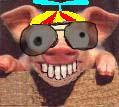 by Real_Aviator » Sun Mar 28, 2004 7:17 am
by Real_Aviator » Sun Mar 28, 2004 7:17 am
VOR's. Simple things. Think of being above your plane, looking down on a 2D plane (scuse the pun).
Lets go to England. Gatwick (EGKK). Tune to 115.3 Thats EGLL's southern arrival hold called Ockham. (London Heathrow - Bugger of an airport to fly in Commercially).
Take off from Gatwick's East runway (08R), and go to 3000ft. When you pass 1500 feet, turn left. Now, this will bring you facing North. As you set the OBS (Omni Bearing Selecter) at 360(deafult), and you are South of the OCK VOR, you will see a TO flag. That is because you are South of the VOR flying TO it. You are flying North, which also happens to be 360 that is set on the OBS.
Intercept the VOR 360 Radial. Bascailly, aim for the needle. Think of it from above. You are pretty much directly south of the OCK VOR. You go to the right, East, and need to turn towards it on the 360. Imagine that line going from South to North through the VOR. You are to the right of it now, flying East, so turning left 90 degrees will take you parallel to it, and a further 45 degrees weill have you intercepting it.
Once the CDI (course deviation indicator) becomes centered, you should be "flying the 360 radial to OCK".
If you continue on that track (DONT USE AUTOPILOT for this NAV excersise, just alt and speed control if you want), you will of course fly over the VOR. When that happens, you are in a "dead zone" where you are neither going TO it or flying FROM it. The needle CDI will go crazy or flip to the side, but eventually when you come out the other side, it will say FROM. Now, you are flying FROM the OCK VOR tracking the 360 Radial.
Apply this concept to any direction and its easy to understand.
Of course, as well as using VORs in real world Navigation, we also use Intersections. These are imaginary points in space, which have been named by two radials of 2 nearby VORs intersecting. A popular one used from South UK airports going to Europe is ORTAC. Do a search and you should find it on the GPS database in FS2004.
Hope this helps.
Dan





 Mainboard: Asus P5K-Premium, CPU=Intel E6850 @ x8x450fsb 3.6ghz, RAM: 4gb PC8500 Team Dark, Video: NV8800GT, HDD: 2x1Tb Samsung F3 RAID-0 + 1Tb F3, PSU: Antec 550 Basiq, OS: Win7x64, Display: 24&
Mainboard: Asus P5K-Premium, CPU=Intel E6850 @ x8x450fsb 3.6ghz, RAM: 4gb PC8500 Team Dark, Video: NV8800GT, HDD: 2x1Tb Samsung F3 RAID-0 + 1Tb F3, PSU: Antec 550 Basiq, OS: Win7x64, Display: 24&

















 ...!
...! ...!
...!